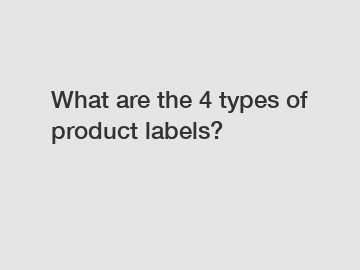What are the 4 types of product labels?
Product labels play an indispensable role in the business world. In a marketplace overflowing with options, consumers rely on these labels to make informed decisions about the goods they purchase. Understanding the different types of product labels is crucial for businesses to effectively communicate the unique qualities and benefits of their offerings. In this article, we will explore the four primary types of product labels, highlighting their distinct functionalities and important considerations. So let's dive in!
1. Informational Labels: Where Clarity Equates to Confidence.
Informational labels are perhaps the most common type, found on a wide array of products, from food items to electronics. These labels primarily focus on providing essential details such as ingredients, usage instructions, nutritional facts, and safety warnings. Accuracy and transparency are paramount here, as customers trust this information to ensure the product aligns with their needs, dietary restrictions, and preferences. Informational labels enable consumers to make well-informed choices, enhancing brand trustworthiness.

2. Branding Labels: Telling Your Story, One Product at a Time.
Branding labels are designed to create a lasting impression and reinforce brand identity. They are an effective means for companies to differentiate themselves from competitors and establish a unique market presence. By incorporating captivating visuals, color schemes, logos, and taglines, branding labels convey the ethos of the brand, capturing the attention of potential customers. Successful branding labels evoke emotions, fostering brand loyalty and recognition.
3. Grade Labels: Quality Assurance and Consumer Confidence.
Grade labels offer an appraisal system, indicating the quality or grade of a product. For example, in the food industry, grade labels may denote the quality of ingredients or the safety regulations adhered to during production. These labels help customers understand the value and reliability of a product, enabling them to make purchasing decisions with confidence. Grade labels are particularly vital in sectors where product quality varies significantly, such as agricultural produce, meat, and seafood products.
4. Eco-Labels: Combining Ethics and Environmental Awareness.
In today's environmentally conscious world, eco-labels have gained significant traction. These labels emphasize a company's commitment to sustainability and eco-friendly practices, presenting consumers with a choice that aligns with their values. Eco-labels often highlight certifications obtained, such as organic, fair trade, or made with renewable materials. By incorporating eco-labels, businesses demonstrate their dedication to social responsibility, attracting like-minded consumers who prioritize environmentally friendly options.
Considerations for Effective Product Labeling:
1. Clarity and Readability: Labels must be easily readable, with legible fonts and appropriate sizing. Avoid cluttering information and use clear language to ensure customers can quickly comprehend the content.
2. Design and Aesthetics: Thoughtful design elements, color schemes, and branding elements help create visually appealing labels that capture attention and leave a lasting impression.
3. Compliance and Regulatory Requirements: It is essential to stay up to date with industry-specific regulations and labeling standards to ensure legal compliance. Regulatory bodies provide guidelines for accurate nutritional information, allergen declarations, and product safety warnings.
4. Label Placement: Considering the physical position of the label on a product is crucial. Strategic placement enhances visibility, making it easier for customers to read and understand the information shared.
Conclusion:
Product labels have evolved beyond their mere informative purpose, becoming powerful tools for businesses to communicate with consumers effectively. Whether it's providing essential details, establishing a brand's identity, assuring quality, or emphasizing environmental awareness, each type of label holds immense value. As businesses navigate the competitive landscape, understanding these four types of product labels and incorporating them intelligently into their marketing strategy is vital. By doing so, they can elevate brand credibility, build customer loyalty, and drive sales in an increasingly discerning marketplace.
If you want to learn more, please visit our website cnprint, cnprint, cnprint.

Comments